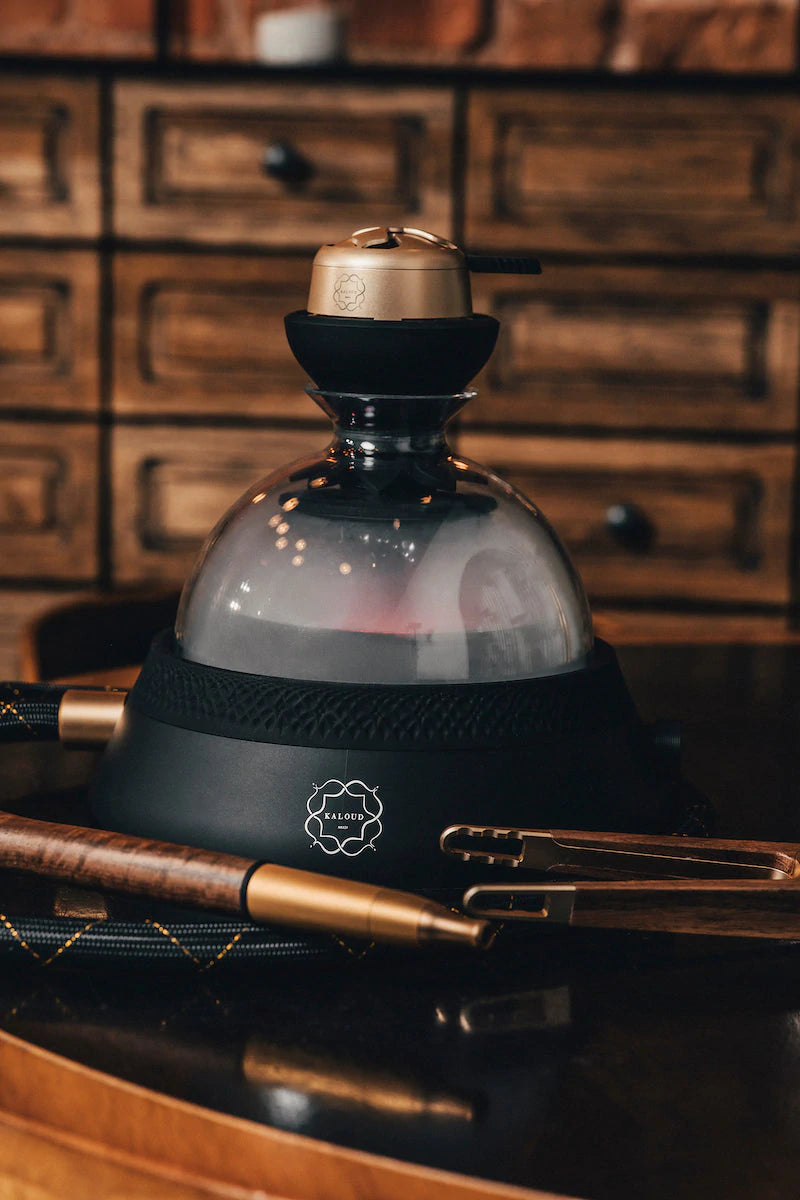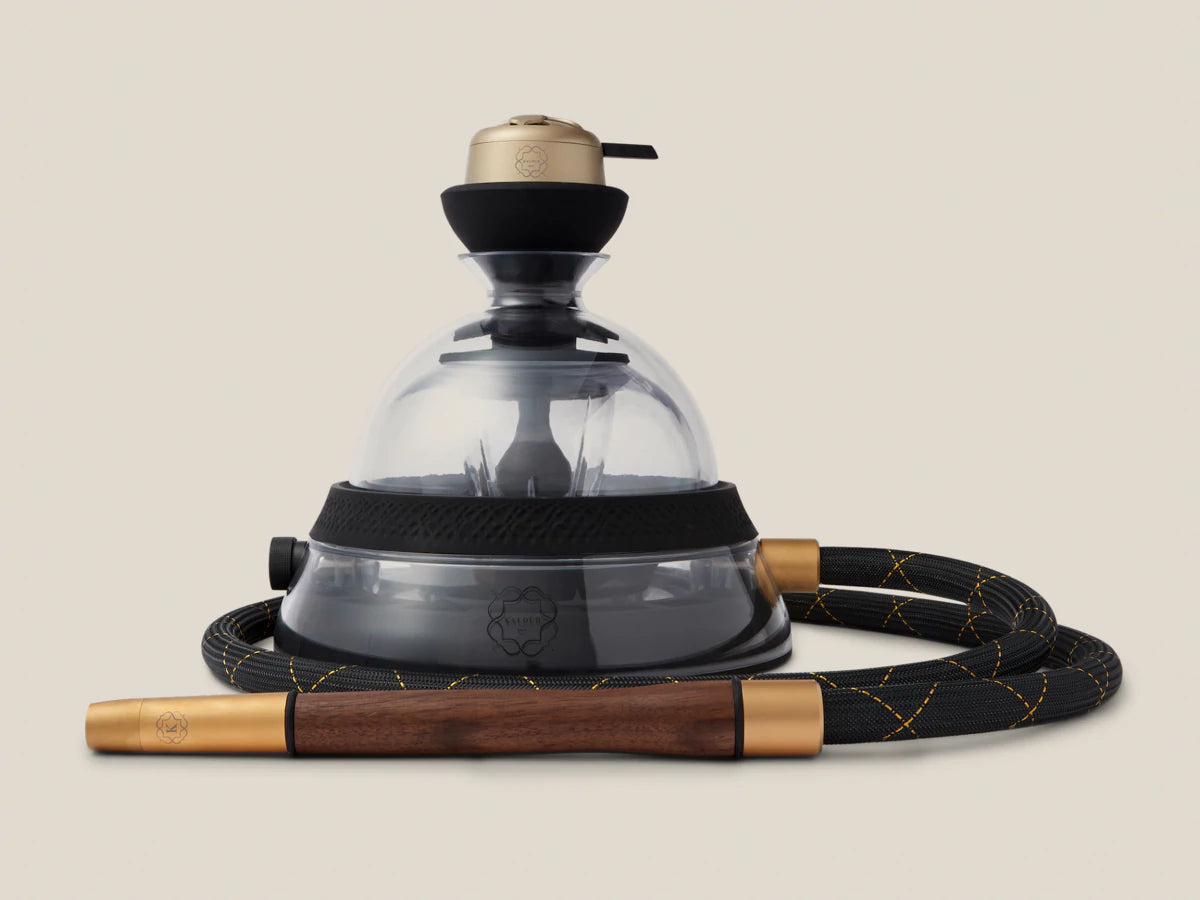Kaloud's 2021 Study On Hookah Smoke Health Effects
Our mission has always been to deliver the smoothest, cleanest, tastiest, puffs so that you enjoy your Hookah Sessions and, hopefully connect in meaningful ways with those you're sharing the experience with.
In this way, we at Kaloud believe that we can Transform the World One Puff at a Time. With that mission in mind, we've created hookah systems, the world's first and best Heat Management Devices, and now, activated carbon hookah filters that help further reduce harmful compounds in Hookah smoke.

By cooking the shisha tobacco rather than burning it and then filtering the smoke through the Ayara Activated Carbon Hookah Filter, we now know that using Kaloud products can significantly reduce physiological harm caused by smoking Hookah compared to a traditional hookah (charcoal on foil with a base and stem system).
As you review these results, it is important to remember that the gasses in Hookah smoke and cigarette smoke are very different. While a Hookah session will typically produce significantly more gas (smoke) than one cigarette, the gas volume is not necessarily an indicator of the harm being caused. In other words, based on our testing, we believe that a cigarette produces significantly more harmful smoke than a Hookah paired with a Kaloud Lotus Heat Management Device and Ayara Activated Carbon Hookah Filter, and this is especially true for a Krysalis Eltheria.
We ask that you do not, in any way, read these results as a claim that our products, or any product for that matter, will make smoking healthy. We can say, however, that we believe when our products are used properly they will lead to a significantly less harmful experience. Please remember that smoking is harmful, and though we believe our products reduce the harm associated with Hookah smoke, all kinds of smoking, including vaping, have been shown to cause physiological damage.
With that being said, we are profoundly pleased to share the results of testing we paid to do with an accredited laboratory in Germany over the course of several months in 2021.
We are committed to cooperating with any other labs or educational institutions that are interested in testing our products and validating or challenging our results. Please contact us for details. (Only accredited labs and institutions please).
The Three Test Conditions:
- Baseline: Standard Hookah with no filter or Lotus Heat Management Device and Two Coconut Hookah Charcoal Cubes
- Minimum Recommendation: Standard Hookah with the Ayara Activated Carbon Hookah Filter and the Lotus Heat Management Device
- Ideal Method: Krysalis Eltheria with the Ayara Activated Carbon Hookah Filter, the Lotus Heat Management Device, and the Samsaris Vitria Bowl
This helped us to determine the impact Kaloud products have on the harmful effects of Hookah Smoke.
Results: Krysalis Eltheria
Over the course of five separate testing cycles on the three conditions identified above, using the Krysalis Eltheria with a Lotus, Samsaris Vitria II, and Kaloud’s Ayara Activated Charcoal Hookah Filters decreased harmful chemicals by a truly significant amount.


Results: Lotus and Ayara
Over the course of five separate testing cycles on the three conditions identified above, using the Lotus and Kaloud's Ayara Activated Carbon Hookah Filters also reduced harmful compounds. These can be used in combination with a standard hookah to deliver some of the health benefits that Kaloud products offer.


Carbonyl Compounds
- Respiratory tract infection
- Damage to skin
- Neurodegenerative disorders
| Carbonyl Compounds | Standard Hookah (baseline) | Standard Hookah & Kaloud Ayara Activated Carbon Hookah Filter & Lotus | Percentage Decrease From Baseline | Krysalis Eltheria & Kaloud Ayara Activated Carbon Hookah Filter & Lotus | Percentage Decrease From Baseline |
|
Formaldehyde
µg /175 puffs
|
778.8 | 238.0 | 69.4 % | 40.2 | 94.8 % |
|
Acetaldehyde
µg /175 puffs
|
866.4 | 216.8 | 74.98 % | 73.4 | 91.5 % |
|
Acetone
µg /175 puffs
|
211.4 | 47.0 | 77.8 % | <LOQ | 100.0 % |
|
Acroleine
µg /175 puffs
|
296.4 | 38.8 | 86.9 % | <LOQ | 100.0 % |
|
Propionaldehyde
µg /175 puffs
|
135.6 | 6.4 | 95.3 % | <LOQ | 100.0 % |
|
Crotonaldehyde
µg /175 puffs
|
16.2 | 3.6 | 77.8 % | <LOQ | 100.0 % |
|
2-Butanone
µg /175 puffs
|
5.2 | <LOQ | 100.0 % | <LOQ | 100.0 % |
|
Butyraldehyde
µg /175 puffs
|
<LOQ | <LOQ | n/a | <LOQ | n/a |
| Average Percentage Decrease (%) | 83.2 % | 98.1 % |
Average Percentage Decrease


Polycyclic Aromatic Hydrocarbons (PAHs)
| Polycyclic Aromatic Hydrocarbons (PAH) | Standard Hookah (baseline) | Standard Hookah & Kaloud Ayara Activated Carbon Hookah Filter & Lotus | Percentage Decrease From Baseline | Kysalis Eltheria & Kaloud Ayara Activated Carbon Hookah Filter & Lotus | Percentage Decrease From Baseline |
|
Naphtalene
µg /175 puffs
|
1.194 | 0.183 | 84.7 % | 0.005 | 99.6 % |
|
Acenaphthylene
µg /175 puffs
|
0.050 | 0.004 | 92.0 % | 0.000 | 100.0 % |
|
Acenaphthene
µg /175 puffs
|
0.199 | 0.030 | 84.8 % | 0.007 | 96.6 % |
|
Fluorene
µg /175 puffs
|
0.228 | 0.015 | 93.6 % | 0.003 | 98.5 % |
|
Phenanthrene
µg /175 puffs
|
1.264 | 0.232 | 81.7 % | 0.046 | 96.4 % |
|
Anthracene
µg /175 puffs
|
0.137 | 0.015 | 88.8 % | 0.006 | 95.8 % |
|
Fluoranthene
µg /175 puffs
|
0.477 | 0.102 | 78.6 % | 0.031 | 93.5 % |
|
Pyrene
µg /175 puffs
|
0.625 | 0.146 | 76.7 % | 0.077 | 87.6 % |
|
Benz[a]anthracene
µg /175 puffs
|
0.062 | 0.008 | 87.7 % | 0.001 | 98.4 % |
|
Chrysene
µg /175 puffs
|
0.079 | 0.009 | 88.4 % | 0.001 | 98.5 % |
|
Benzo[b]fluoranthene
µg /175 puffs
|
0.067 | <LOQ | <LOQ | 0.001 | 97.9 % |
|
Benz[k]fluoranthen
µg /175 puffs
|
0.002 | <LOQ | 100.0 % | <LOQ | 100.0 % |
|
Benzo[a]pyrene
µg /175 puffs
|
0.018 | <LOQ | <LOQ | <LOQ | 100.0 % |
|
Benzo[g,h,i]perylene
µg /175 puffs
|
0.040 | <LOQ | 100.0 % | <LOQ | 100.0 % |
|
Dibenzo[a,h]anthracene
µg /175 puffs
|
<LOQ | <LOQ | n/a | <LOQ | n/a |
|
Indeno[1,2,3-cd]pyrene
µg /175 puffs
|
0.008 | <LOQ | 100.0 % | <LOQ | 100.0 % |
| Average Percentage Decrease (%) | 90.5 % | 97.5 % |
Average Percentage Decrease


The Safer Option, period.
Tested componds were always lower when you use a Krysalis Eltheria compared to a standard hookah, without a charcoal filter.

Volatile Organic Compounds (VOCs)
| Volatile Organic Compounds (VOC) | Standard Hookah (baseline) | Standard Hookah & Kaloud Ayara Activated Carbon Hookah Filter & Lotus | Percentage Decrease From Baseline (%) | Kysalis Eltheria & Kaloud Ayara Activated Carbon Hookah Filter & Lotus | Percentage Decrease From Baseline (%) |
|
1,3-Butadiene
µg /175 puffs
|
<LOQ | <LOQ | n/a | <LOQ | n/a |
|
Isoprene
µg /175 puffs
|
<LOQ | <LOQ | n/a | <LOQ | n/a |
|
Acrylonitrile
µg /175 puffs
|
<LOQ | <LOQ | n/a | <LOQ | n/a |
|
Benzene
µg /175 puffs
|
205.5 | 36.4 | 82.3% | 63.7 | 68.99% |
|
Toluene
µg /175 puffs
|
75.1 | <LOQ | 100.0% | <LOQ | 100.0% |
| Average Percentage Decrease (%) | 91.2 | 84.5 |
Average Percentage Decrease


Carbon Monoxide (CO)
| Carbon Monoxide | Standard Hookah (baseline) | Standard Hookah & Kaloud Ayara Activated Carbon Hookah Filter & Lotus | Percentage Decrease From Baseline | Kysalis Eltheria & Kaloud Ayara Activated Carbon Hookah Filter & Lotus | Percentage Decrease From Baseline |
|
Carbon Monoxide
µg /175 puffs
|
199.8 | 78.3 | 60.8 % | 129.9 | 34.97 % |
Average Percentage Decrease


Additional Notes
- Our first condition used a standard Hookah with foil and bowl with two coconut Hookah Charcoal cubes according to ISO Standards for testing Hookah Smoke.
- Our second and third conditions each used three cubes of coconut Hookah Charcoal to account for the Kaloud Lotus and which still yielded spectacular results.
- Our second condition used a Kaloud Lotus, Samsaris Vitria II, and an Ayara Activated Carbon Hookah Filter.
- Our third condition used a Krysalis Eltheria with a Lotus, Samsaris Vitria II, and built in Ayara Activated Carbon Hookah Filter.
- We hope to conduct further testing in 2022 on the Krysalis Calix, Lotus III, and Sitra Thermal Diffuser. We used a lid on the Lotus in all tests.
- The addition of any more charcoal cubes will introduce more harmful compounds and also overheat the shisha tobacco, which is also very harmful.
- Please use the Lotus lid whenever possible as it will help with heat management and reducing harm.
- None of our results are applicable to any other counterfeit or copy of any Kaloud Lotus and also do not apply to any other Heat Management Device, especially devices that focus on physical contact with the Hookah Tobacco.





